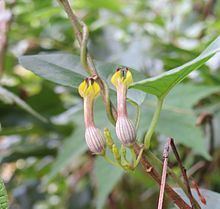Rank Species | ||
 | ||
Similar Ceropegia bulbosa, Ceropegia elegans, Ceropegia fantastica, Ceropegia jainii, Ceropegia pusilla | ||
Tertiary ingredients of ceropegia candelabrum formulations pankaj oudhia s medicinal plant database
Ceropegia candelabrum is a plant species from the subfamily Asclepiadoideae. The specific epithet is derived from the candelabra-like appearance of the inflorescences.
Contents
- Tertiary ingredients of ceropegia candelabrum formulations pankaj oudhia s medicinal plant database
- Vegetative characteristics
- Inflorescence and flowers
- Geographic distribution and ecology
- Human use and medical importance
- Systematics and taxonomy
- Literature
- References
Vegetative characteristics
Ceropegia candelabrum is a perennial, succulent, twining plant with a roundish tuber. The strong, bare shoots have a diameter of 3 to 4 mm. The leaves are stalked. The slightly fleshy leaf blades are linear, elliptical to rounded tip sharpened. They are 2 to 7 cm long and 0.8 to 3.5 cm wide.
Inflorescence and flowers
The inflorescence is borne on a 1 to 3 cm long stem. The bill umbels carry 5 to 12 flowers. The flower stems are 3 to 10 mm long, the sepals about 4 mm. The corolla is 2.5 to 4.5 cm high, greenish yellow colored with red-brown stripes.
Geographic distribution and ecology
The species is found in India and Sri Lanka as well as in Vietnam before. In India, it blooms from August to January. Fruits are formed from September to January.
Human use and medical importance
The tuberous roots are edible and are eaten especially by the poorest raw or cooked. The plant is also used for various medicinal purposes, so for hemorrhoids, indigestion, headaches and against bites of poisonous animals .
Ceropegia candelabrum is now in the original area has become quite rare. There are already projects for artificial propagation.
Systematics and taxonomy
The species was first described in 1753 by Carl Linnaeus. He referred to table 16 of Hortus Indicus Malabaricus published in 1689 by Henricus van Rhede. In 1795 the species was described again by William Roxburgh as Ceropegia tuberosa, making C. tuberosa a junior synonym of C. candelabrum. Ceropegia candelabrum is the type species of the genus Ceropegia L.
Japtap et al. (1999) distinguish two varieties: Ceropegia candelabrum var. candelabrum and Ceropegia candelabrum var. biflora (L.) Ansari The varieties are not listed by the Plant List, nor the Ceropegia Checklist [8].
Literature
MY Ansari: Asclepiadaceae: Genus Ceropegia. In: fascicles of Flora of India, Fascicle 16, 1984, S.1-34, Botanical Survey of India, Howrah (S.10-12)
Joseph Dalton Hooker (assisted by various botanists): The flora of British India. Volume 4. Asclepiadeae to Amarantaceae. London, Reeve & Co., 1885. Online at www.biodiversitylibrary.org (p. 70)
Herbert F. J. Huber: Revision of the genus Ceropegia. In: Memórias da Sociedade Broteriana, Volume 12, 1957, S.1-203, Coimbra (S.58-60)
AP Jagtap, N. Singh, N .: Asclepiadaceae and Periplocaceae. In: fascicles of Flora of India, Fascicle 24, 1999 S.211-241, Botanical Survey of India, Kolkata (p. 218 / 9).
Ulrich Meve: Ceropegia. In: Focke Albers, Ulrich Meve (ed.): Sukkulentenlexikon Band 3 Asclepiadaceae (milkweed family). S. 61-107, Eugen Ulmer Verlag, Stuttgart 2002, ISBN 3-8001-3982-0.
